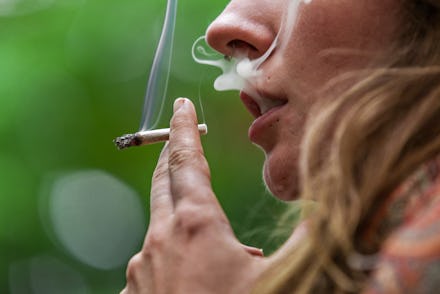Young people are higher than ever

Everyone adopted a go-to self-soothing method during the pandemic. Some people, as copious pie and sourdough posts on IG have proven, have been baking their way through it. Many college kids, on the other hand, are getting baked. Nearly half of the ones surveyed in a recent poll reported consuming weed last year (a record high) while slightly over half reported drinking booze, which is a record low, according to a new study. Apparently, it’s weed over alcohol during these trying times.
Sponsored by the National Institute on Drug Abuse (NIDA), the “Monitoring the Future Study” has looked at drug use among 19- to 22-year-olds in the U.S. for the past 40 years, the Washington Post reported. For the 2020 edition, researchers surveyed 1,550 folks who fell within this age range from March 20 to November 30 of last year, after the pandemic hit.
Forty-four percent of college students responded that they’d consumed cannabis in last year, the Post reported, up from 38% in 2015. “Daily or nearly daily” weed consumption saw a 3% bump over that same time period.
Contrary to the keg-guzzling frat bro stereotype, the percentage of college kids who reported drinking alcohol fell from 62% to 56% between 2020 and 2019, per the Post. During that period, the proportion of those who said they’d engaged in binge drinking — or knocking back five or more drinks on at least one occasion in the past two weeks — dropped from 32% to 24%
While the study didn’t examine what drove these trends, scientists have proposed some theories. “The pandemic seems to have actually made marijuana into an alternative to escape the monotony of isolation,” Nora Volkow, director of NIDA, told the Post. “It’s made life become more boring, more stressful. So if drugs let you experience that completely different mental state, I wonder whether that would be a factor that leads people to use them.”
John Schulenberg, a professor of psychology at the University of Michigan and the study’s principal investigator, said to the outlet that young people view alcohol as something to imbibe at parties and other social events, all of which the pandemic cancelled. The dip in drinking seen in the study also seems to align with what millennials told Mic earlier this year about pandemic drinking no longer being fun.
At least based on my experience, weed alters my temporal and sensory perception in ways that booze doesn’t, making it feel like more of an escape. I wonder if that could help explain why more college kids turned to the former, less to the latter. This seems consistent with another fascinating survey finding — 9% college students said they used psychedelics last year, versus only 5% the year before. Again, though, this is just speculation and nothing that’s been tested in a controlled study.
The trends the report uncovered might also have to do with the fact that cannabis is pretty easy to access in the U.S. Eighteen states have legalized recreational weed for adults over 21, according to the Post, and 37 have legalized medical marijuana.
And in places where recreational use is still illegal, some students consume “hemp with Delta-8 THC, which currently inhabits a legal gray zone despite being intoxicating, albeit less so than Delta-9 THC,” Susan A. Stoner, a research scientist at the University of Washington’s Addictions, Drug and Alcohol Institute, told the newspaper. (I kid you not: Her last name really is Stoner.)
As Mic previously reported, when folks say “THC” — short for tetrahydrocannabinol, the compound in weed that gets you lifted — they usually mean “Delta-9-THC.” Delta-8-THC is another form of THC, which is half as potent as delta-9 THC (hence its reputation as "weed lite.")
But while the U.S. has warmed up to cannabis, that doesn’t mean it’s harmless. Regular use can harm young people’s development, and has been associated with a higher risk of psychosis and suicidal thinking, all of which are especially concerning during an already stressful pandemic, Volkow told the Post. In a NIDA study of 18- to 35-year-olds she helped conduct, weed users were at higher risk for suicidal thoughts, plans, and attempts.
Personally, I’m all for harm reduction and mindful consumption of cannabis and alcohol. But I also believe in having a diversity of coping skills at our disposal, so none of them ends up being a crutch. With the pandemic ongoing and the mental health repercussions sure to be felt even after it does end, as Volkow pointed out, I think it’s worth changing up our strategies for coming to terms with our new reality, beyond numbing ourselves to or escaping it.